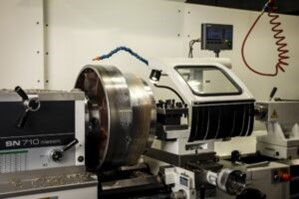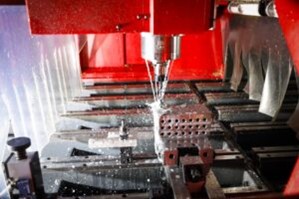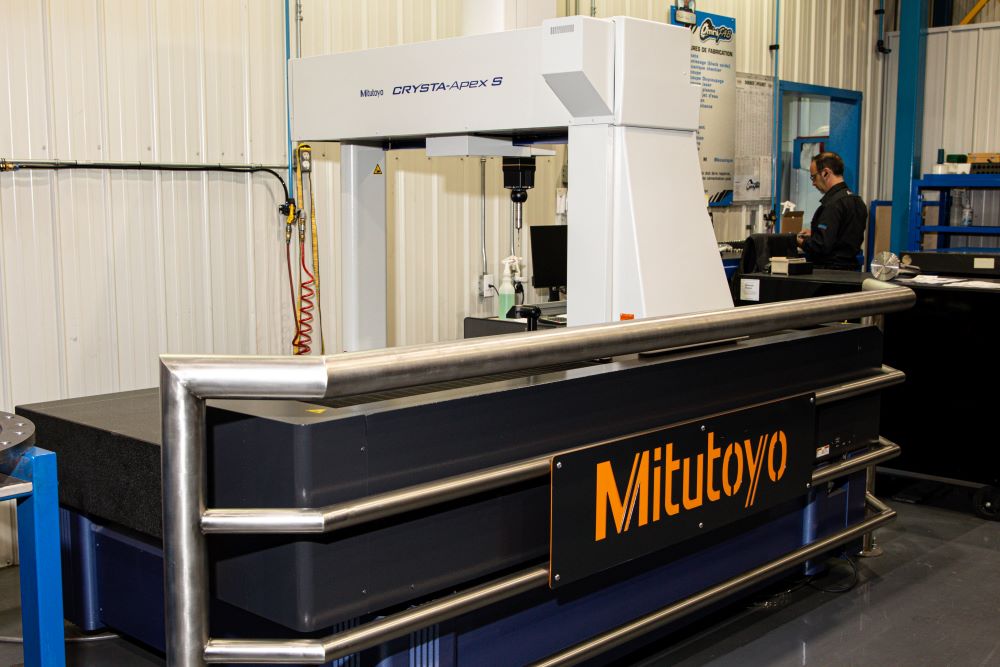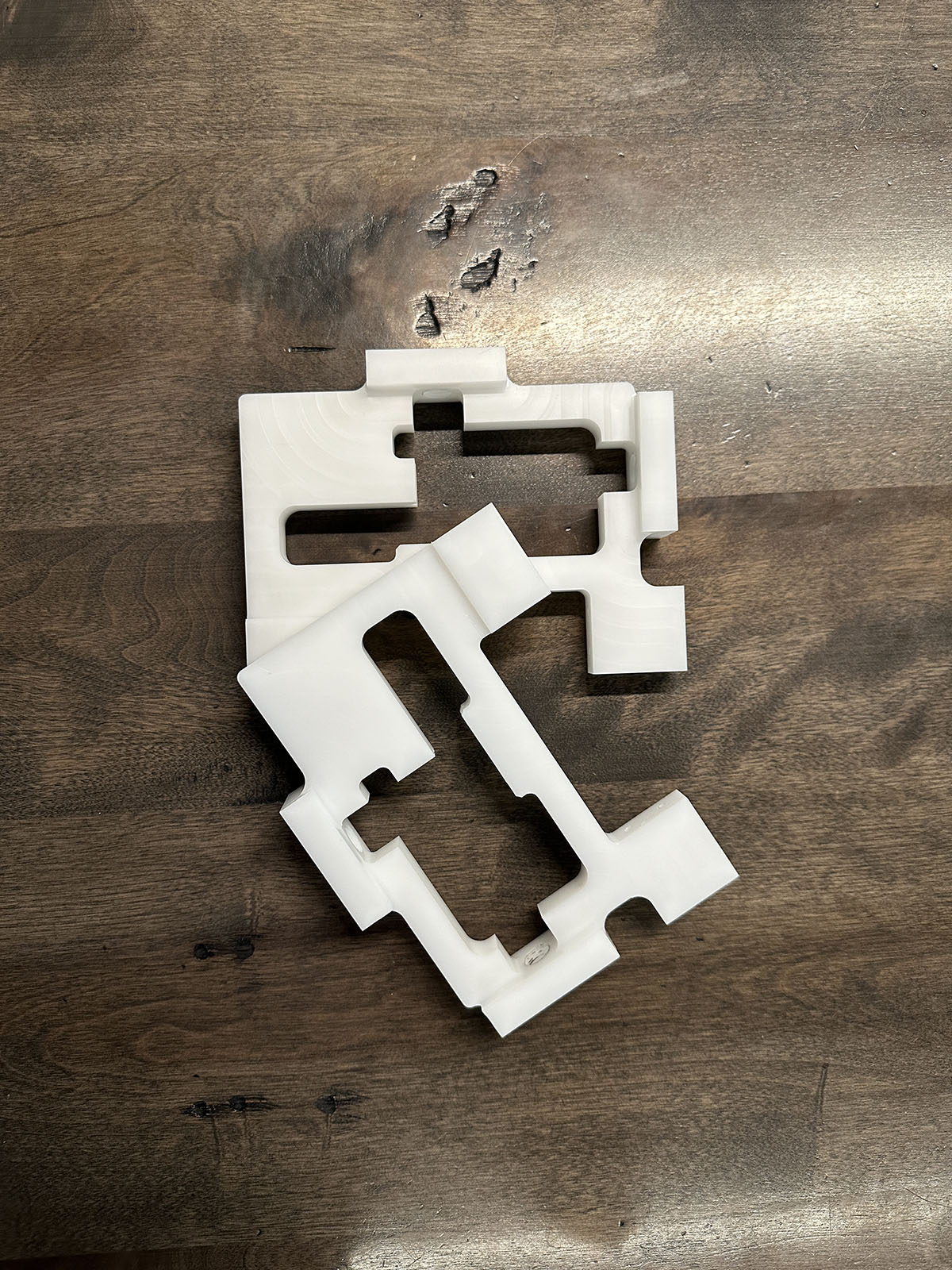When manufacturing a mechanical part from a block of raw material, various machining operations can be used to remove excess.
In this text, we briefly present those most often used by our machinists when carrying out machining mandates:
- Turning
- Drilling
- Reaming;
- Tapping;
- Milling;
- Rectification.
Turning
Turning is a machining process performed using a lathe, a machine tool that comes in both conventional and CNC versions. The former is operated manually by a machinist, while the latter is digitally controlled by computer.
During the turning operation, the workpiece is held in place on the lathe by a chuck. The lathe rotates the workpiece, and cutting tools cut through it to remove metal.
The cutting tools work along two axes of movement, depth and width, to create precise cuts. This is an ideal technique for quickly removing large quantities of material.
Turning is frequently used to manufacture cylindrical components such as rollers and shafts. It’s also the technique of choice for creating concentric shapes on the outer circumference of a part with a cylindrical profile.
Slots, annular grooves, stepped shoulders, internal and external threads : many round or circular features can be produced by turning. It’s also possible to produce smooth, uniform surface finishes using a machining lathe.
Drilling
Drilling is the process of producing cylindrical holes in solid materials using drills. Typically, a drill press is used for drilling operations, but bits can also be mounted on lathes.
The bits used usually have two spiral channels running along the drill shank. Known as flutes, these channels transport the chips out of the hole as the drill progresses through the material. For each type of material, there is a recommended drilling speed.
Drilling is a more delicate machining operation than it might seem, as machinists have to take into account the flexibility of drills (especially when they heat up due to friction) and the fact that they tend to follow the path of least resistance.
Reaming
Reaming is a subtractive machining process generally used to refine the dimensions and precision of existing or freshly drilled holes (hole calibration).
This machining operation offers high precision and is easily reproducible. Reaming is performed using a reamer, a machine tool with a single-point cutting tool or reaming head.
Reaming machines come in several versions. With a vertical reamer, the workpiece rotates while the reaming bar is held stationary. Horizontal and jig reamers hold the workpiece stationary and rotate the cutting tool. In some cases, reaming can also be performed on a lathe or machining center.
Do you have parts to be machined quickly?
Tapping
Tapping is a machining operation that produces a thread inside a bore.
Taps operate either by deformation or by cutting. In the latter case, tapping can be performed either manually or using a machine (milling machine, drilling machine, lathe, etc.).
Milling
Milling is a machining operation performed using a milling machine, a piece of equipment that uses a rotating cutter mounted on a spindle to remove material. Milling cutters come in a variety of shapes and have several cutting edges.
On most traditional milling machines, the cutting tool is stationary and it’s the table that moves along the X and Y axes. However, to enable precise cuts of the desired shape, many modern milling machines will work the raw material on 3 and sometimes even 5 axes. This is known as a “machining center”, a state-of-the-art, computer-controlled machine tool in which even milling cutter changes are automated.
Although a milling machine can also drill holes and bores, it excels at removing material from more complex, asymmetrical parts. Milling cutters are used to produce square or flat faces, notches, chamfers, channels, profiles, grooves and other features that depend on high-precision cuts.
Grinding
Grinding is a finishing process used to remove small amounts of material from flat surfaces and cylindrical shapes. This is usually done by abrasion using a machine called a grinder, the most common models of which are surface grinders and cylindrical grinders.
Surface grinders move the workpiece back and forth on a table while inserting it into the grinding wheel. The depth at which the grinding wheel cuts is generally between 6.35 and 25.4 μm (micrometers).
Cylindrical grinders mount the workpiece on centers and spin it while simultaneously applying the periphery of a rotating abrasive wheel. Double-disc grinding is another method, whereby workpieces are passed, once or several times, between two grinding wheels rotating in opposite directions.
Other machining operations
Although the machining operations discussed in the previous paragraphs are generally sufficient to create mechanical parts of all kinds, there are other techniques and processes worth mentioning.
These include :
- Planing (to create flat surfaces);
- Sawing (to create shorter lengths from bars or tubes);
- Broaching (to create square holes, keyways, fluted holes and more);
- Shaping (to cut out shapes such as slots and grooves inside parts).
- For your machining needs, rely on Omnifab experts
In conclusion, although these machining operations can be used for most parts manufacturing projects, many other techniques and skills may be required to complete your projects.
That’s why, in our workshop equipped with the best machine tools, we also do welding, assembly, laser cutting, metal bending and industrial mechanics. All with the goal of offering you a complete turnkey machining service that shortens lead times and eliminates the need for subcontracting.
Don’t hesitate to contact us for a quote, even if it’s for on-site machining or large-scale machining jobs.






